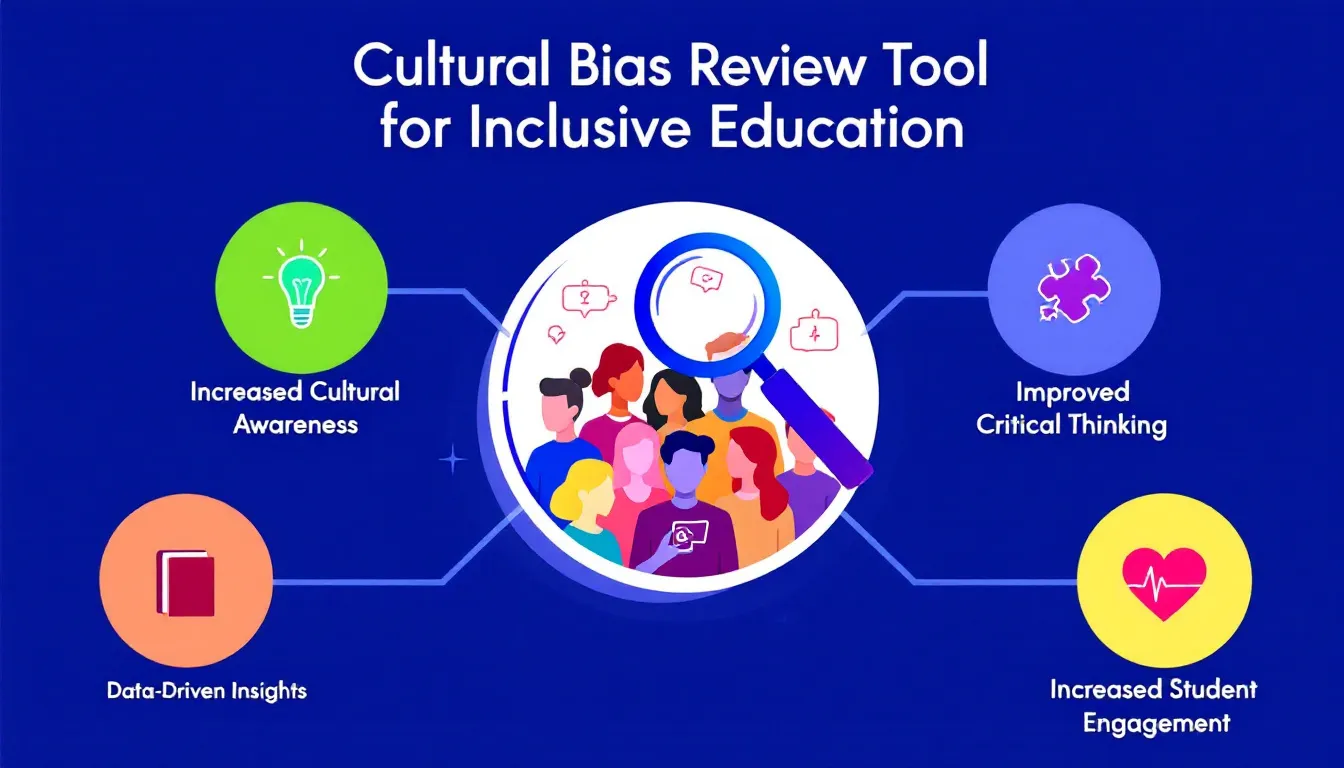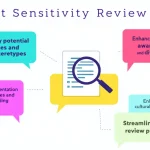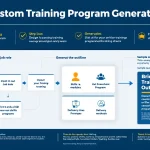Cultural Bias Review Tool
Is this tool helpful?
How to Use the Cultural Bias Review Tool Effectively
To make the most of our Cultural Bias Review Tool, follow these simple steps:
- Enter Course Module Content: In the first text area, paste the full content of the course module you want to review. This should include all text, activities, assessments, and instructions. For example, you might input a lesson on World History covering the Industrial Revolution, or a module on Global Literature discussing various cultural narratives.
- Specify Target Audience (Optional): In the “Target Audience” field, describe the intended learners for your course. This helps the tool consider specific cultural contexts. For instance, you might enter “Undergraduate students in a multicultural urban university” or “Adult learners in a global online program.”
- Provide Cultural Context (Optional): Use the “Cultural Context” field to specify any particular cultural backgrounds to consider during the review. You could input “Middle Eastern and South Asian perspectives” or “Indigenous and Western viewpoints” to ensure these contexts are taken into account.
- Submit for Review: Click the “Review for Cultural Bias” button to initiate the analysis.
- Review Results: Once processing is complete, the tool will display a comprehensive review highlighting potential cultural biases and suggesting improvements.
- Copy and Implement: Use the “Copy to Clipboard” button to easily transfer the recommendations to your preferred editing tool for implementation.
By following these steps, you’ll receive a thorough analysis of your course module, helping you create more inclusive and culturally sensitive educational materials.
Understanding Cultural Bias in Educational Content: An Introduction
Cultural bias in educational materials is a critical issue that can significantly impact the learning experience and outcomes for students from diverse backgrounds. Our Cultural Bias Review Tool is designed to help instructional designers, educators, and content creators identify and address potential biases in their course modules, promoting inclusivity and cultural sensitivity in educational settings.
What is Cultural Bias?
Cultural bias refers to the tendency to interpret and judge phenomena through the lens of one’s own cultural standards, often leading to misunderstandings or misrepresentations of other cultures. In educational contexts, cultural bias can manifest in various ways:
- Stereotypical representations of certain cultures or ethnic groups
- Overemphasis on Western perspectives in global topics
- Use of culturally insensitive language or examples
- Neglect of diverse cultural contributions to a field of study
- Assumptions about students’ prior knowledge or experiences
The Importance of Addressing Cultural Bias
Addressing cultural bias in educational materials is crucial for several reasons:
- Inclusive Learning Environment: It creates a more welcoming and inclusive learning environment for all students.
- Enhanced Engagement: Culturally responsive content can increase student engagement and motivation.
- Broader Perspectives: It exposes students to diverse viewpoints, fostering critical thinking and global awareness.
- Improved Learning Outcomes: Students are more likely to succeed when they see themselves and their experiences reflected in the curriculum.
- Preparation for Diverse Workplaces: It better prepares students for interaction in diverse professional settings.
The Role of the Cultural Bias Review Tool
Our Cultural Bias Review Tool serves as a powerful ally in the quest for more inclusive education. By leveraging advanced language processing and cultural awareness algorithms, it provides a comprehensive analysis of course content, identifying potential biases and offering suggestions for improvement. This tool empowers educators to create materials that resonate with a diverse student body, fostering a more equitable and effective learning environment.
Benefits of Using the Cultural Bias Review Tool
Incorporating the Cultural Bias Review Tool into your instructional design process offers numerous advantages:
1. Time and Resource Efficiency
Manually reviewing course content for cultural bias can be a time-consuming process, often requiring input from multiple experts. Our tool streamlines this process, providing rapid, comprehensive analysis and freeing up valuable time for content creation and refinement.
2. Consistency in Bias Detection
Human reviewers may have varying levels of cultural awareness or unconscious biases of their own. The Cultural Bias Review Tool applies consistent criteria across all content, ensuring a standardized approach to bias detection.
3. Broadened Cultural Perspective
The tool’s database encompasses a wide range of cultural contexts and sensitivities, potentially identifying biases that might be overlooked by individual reviewers with limited cultural exposure.
4. Continuous Learning and Improvement
By regularly using the tool, instructional designers can develop a keener awareness of cultural biases, improving their ability to create inclusive content from the outset.
5. Enhanced Student Satisfaction and Performance
Creating more culturally inclusive content can lead to increased student engagement, satisfaction, and academic performance, particularly among diverse student populations.
6. Institutional Reputation
Educational institutions that prioritize cultural inclusivity in their curricula can enhance their reputation, potentially attracting a more diverse student body and faculty.
Addressing User Needs and Solving Specific Problems
The Cultural Bias Review Tool is designed to address several key challenges faced by educators and instructional designers:
1. Identifying Subtle Biases
Often, cultural biases in educational materials are not overt but subtle and unintentional. The tool employs sophisticated language analysis to detect these nuanced biases. For example, it might identify an overreliance on examples from a particular culture in a economics course, suggesting more diverse case studies to provide a global perspective.
2. Balancing Perspectives
In subjects like history or literature, presenting a balanced view of different cultural perspectives can be challenging. The tool can help identify areas where additional viewpoints could be incorporated. For instance, in a module on the Industrial Revolution, it might suggest including perspectives from colonized nations alongside those of industrializing Western countries.
3. Adapting Language for Inclusivity
The tool can identify language that may be exclusionary or insensitive to certain cultural groups. It might suggest replacing idioms that don’t translate well across cultures or recommend more inclusive terminology. For example, changing “mankind” to “humankind” to be more gender-inclusive.
4. Addressing Assumptions about Prior Knowledge
Educational content often makes assumptions about students’ background knowledge, which can disadvantage those from different cultural contexts. The tool can highlight where such assumptions are made and suggest ways to provide necessary context. For instance, in a literature course, it might recommend providing brief explanations of cultural references that may not be familiar to all students.
5. Enhancing Visual Representation
While primarily focused on text, the tool can also provide guidance on improving visual elements for cultural inclusivity. It might suggest ensuring diverse representation in images or caution against using stereotypical visual depictions of certain cultures.
Practical Applications and Use Cases
The Cultural Bias Review Tool has wide-ranging applications across various educational contexts. Here are some practical examples of how it can be used:
1. Curriculum Development for International Programs
A university developing an online Master’s program in Global Business Management could use the tool to ensure that course materials are suitable for a diverse, international student body. The tool might suggest:
- Including case studies from various global markets, not just Western economies
- Addressing different cultural approaches to business ethics and leadership
- Highlighting diverse business leaders and entrepreneurs from around the world
2. Updating History Textbooks
A publisher revising a high school World History textbook could utilize the tool to ensure a more balanced global perspective. The analysis might recommend:
- Expanding sections on non-Western civilizations
- Including more primary sources from diverse cultural perspectives
- Revising language that presents Western development as the default narrative of progress
3. Designing Language Learning Materials
A team creating English as a Second Language (ESL) materials could use the tool to ensure cultural sensitivity and relevance. Suggestions might include:
- Diversifying names and cultural references in example sentences and dialogues
- Including activities that celebrate students’ home cultures alongside target language culture
- Avoiding potentially offensive or stereotypical depictions of different nationalities
4. Developing Science Curricula
Science educators creating a new biology curriculum could benefit from the tool’s analysis to make content more globally relevant. The tool might propose:
- Including examples of scientific contributions from various cultures and regions
- Addressing how different cultures have historically approached scientific inquiry
- Ensuring that human biology examples represent diverse ethnic backgrounds
5. Creating Professional Development Courses
An organization developing cultural competency training for educators could use the tool to ensure their own materials are exemplary. Recommendations might include:
- Balancing perspectives from majority and minority cultures
- Including scenarios that challenge common cultural assumptions
- Suggesting resources from diverse cultural experts in the field
Frequently Asked Questions (FAQ)
Q1: How does the Cultural Bias Review Tool define cultural bias?
A1: The tool defines cultural bias as any content, language, or perspective that unfairly favors one cultural viewpoint over others or presents information in a way that may alienate or disadvantage learners from diverse cultural backgrounds. This includes stereotypes, ethnocentric viewpoints, and assumptions about shared cultural knowledge or experiences.
Q2: Can the tool review content in languages other than English?
A2: Currently, the tool is optimized for English-language content. However, we are working on expanding its capabilities to include other major languages in future updates.
Q3: How often should I use the Cultural Bias Review Tool in my course development process?
A3: It’s recommended to use the tool at multiple stages of your course development process. Use it during initial content creation to guide your writing, after completing a draft to catch any overlooked biases, and as part of your final review process before publication or distribution.
Q4: Can the tool help with visual content like images and videos?
A4: While the tool primarily focuses on text-based content, it can provide general guidelines for visual content. For a comprehensive review of visual materials, we recommend combining the tool’s suggestions with human review by individuals with diverse cultural backgrounds.
Q5: How does the tool stay updated with evolving cultural sensitivities?
A5: Our team of cultural experts and data scientists regularly update the tool’s algorithms and databases to reflect current research on cultural inclusivity and evolving societal norms. We also incorporate feedback from users to continually improve the tool’s effectiveness.
Q6: Is the Cultural Bias Review Tool suitable for K-12 education materials?
A6: Yes, the tool can be valuable for K-12 materials. It’s particularly useful for ensuring age-appropriate cultural sensitivity and for creating inclusive content that reflects the diverse backgrounds of young learners.
Q7: How can I integrate the tool’s suggestions while maintaining the integrity of my course content?
A7: The tool provides suggestions, not mandates. Use its recommendations as a starting point for reflection and revision. Balance cultural sensitivity with your educational objectives, and don’t hesitate to seek additional input from cultural experts or diverse focus groups when necessary.
Q8: Can the tool help in creating content for specific cultural contexts?
A8: While the tool is designed to promote general cultural inclusivity, you can use the optional “Cultural Context” field to specify particular cultures you want to consider. This can help tailor the analysis to your specific needs, though it’s always beneficial to combine this with input from individuals familiar with the target cultural context.
Q9: How does the Cultural Bias Review Tool compare to human review?
A9: The tool is designed to complement, not replace, human review. It offers consistency and can identify subtle biases that humans might miss, but human reviewers bring nuanced understanding and contextual interpretation that are invaluable. For best results, use the tool in conjunction with diverse human reviewers.
Q10: Can the tool help in revising existing courses, or is it only for new content?
A10: The Cultural Bias Review Tool is equally effective for reviewing existing courses and creating new content. In fact, it can be particularly valuable for updating older materials to meet current standards of cultural inclusivity.
Important Disclaimer
The calculations, results, and content provided by our tools are not guaranteed to be accurate, complete, or reliable. Users are responsible for verifying and interpreting the results. Our content and tools may contain errors, biases, or inconsistencies. We reserve the right to save inputs and outputs from our tools for the purposes of error debugging, bias identification, and performance improvement. External companies providing AI models used in our tools may also save and process data in accordance with their own policies. By using our tools, you consent to this data collection and processing. We reserve the right to limit the usage of our tools based on current usability factors. By using our tools, you acknowledge that you have read, understood, and agreed to this disclaimer. You accept the inherent risks and limitations associated with the use of our tools and services.







